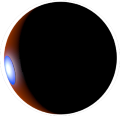Omaha Shield:
A triad of radiation protection systems to enable the Unlimited Mars Career (UMC).
The proposed “Omaha Field” is the third of three components of the Lake Matthew Team’s “Omaha Shield” design; the last component to be specified and quantified. The Omaha Field aims to fill a final gap in end-to-end mission radiation protection, thereby enabling the “Unlimited Mars Career (UMC)”. The team’s UMC goal is to ensure that no crewmember suffers a career-limiting radiation dose, over any career duration on Mars. McGirl et al. 2016 gives one statement of the envisioned challenge.
Omaha Shield: a Protective Triad
1. Omaha Crater
MATT’s Omaha Crater is a region of warm bedrock sited within icy terrain, giving abundant water for facility use. Treated water gives full cosmic ray protection to pressurized facilities. The water covers facility domes to an average depth of 15 m, sufficient to block essentially all cosmic ray protons and other ionizing radiation, while admitting sufficient sunlight for natural-light greenhouses.
2. Omaha Trail
The proposed Omaha Trail facilities offer radiation protection to crews in transit between Earth and Mars. For each crewed mission water is harvested from Deimos, to be shuttled between planets as a 130-ton cosmic ray shield that’s dumped prior to landing. En route to Mars the water shields against ~90% of solar flare protons, and many other cosmic rays. Also the proposed tether-rail launcher at Deimos increases the speed of flights to Earth, to reduce radiation exposure even further on the way home. On the Omaha Trail, solar storm shelters should become a thing of the past.
3. Omaha Field
An artificial local geomagnetic field is proposed, with similarities to a previous NASA idea for an artificial martian magnetic shield. This proposed field is smaller: it protects Omaha Crater’s open ground surface from cosmic rays at close range. The design applies technology from superconducting power lines, superconducting solenoids, and superconducting magnetic energy storage (SMES) units. Magnetostatic modeling indicates that the field can deflect all solar storm protons, nearly all solar flare protons, and over 90% of galactic cosmic ray protons. Such protective fields could also be installed beyond Omaha Crater, at other sites having vertical relief.
Addendum July 25 2018, re Omaha Field:
SpaceX is presently thinking along the very same lines.
From our perspective, “A rose by any other name would smell as sweet.”

Acting in concert, Omaha Shield systems have potential to offer a high degree of protection for every mission profile. This opens the prospect of the UMC. To reiterate, the UMC aims to ensure that no crewmember suffers a career-limiting radiation dose, over any career duration on Mars.
The UMC prospect can reset expectations for Mars missions. In effect, the UMC would allow space agencies and firms to promote Mars as a career-duration target; i.e., no longer as a one-off mission target, offering just one flight opportunity. The UMC could expand the roster of candidates, increase job satisfaction, and slow crew turnover.
There is reason to think that modest R&D can advance the Omaha Shield to technical maturity within the next two decades. Such a schedule would synchronize Omaha Shield deployment and UMC initiation with the earliest feasible creation of Omaha Crater, in 2036.
Other protective methods are conceivable of course, and there is much opportunity for technical cross-pollination within the framework of the Omaha Shield. As given today, the Omaha Shield demonstrates that the UMC is possible, and this new possibility lifts the imagination to that goal.
More Information on the Omaha Shield
1. Omaha Crater
For details of MATT’s Omaha Crater and its protective terraformation resources, see the LakeMatthew.com homepage and this site note on Omaha Crater.
2. Omaha Trail
For details of the Omaha Trail proposal for efficient transport and deep-space cosmic ray protection, see the November 2017 British Interplanetary Society Space Elevator Feasibility presentation and Omaha Trail presentation. For additional details see the original Omaha Trail proposal, an ISEC presentation from August 2017.
3. Omaha Field
For details of the Omaha Field proposal for magnetostatic open-ground cosmic ray protection, see the Mars Home Planet challenge entry, “Artificial Geomagnetic Field to Protect a Crewed Mars Facility from Cosmic Rays”.
Contacts:
Lake Matthew Team
Dr. Martin Lades






